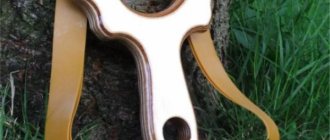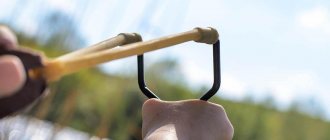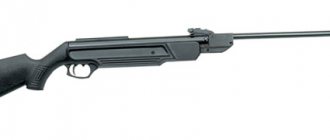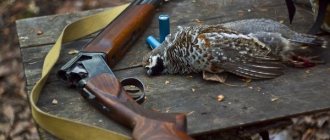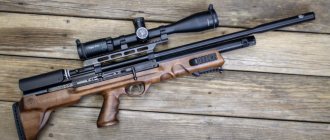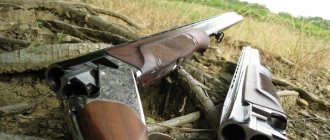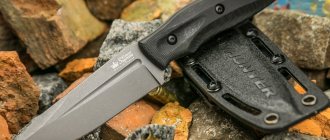Attention! Hunting with a slingshot is prohibited on the territory of the Russian Federation; this information is provided for informational purposes only. Follow the hunting rules and laws of your country.
Many experienced hunters have a rather contradictory attitude towards this type of weapon, such as a hunting slingshot. And there are reasons for this, since without understanding this type of weapon, it is difficult to imagine how it could be better than a gun and a carbine. However, hunting with a slingshot has a number of advantages, you just need to study the “subject” in more detail. For example, using a slingshot you can successfully hunt squirrels, hares, muskrats and otters. There were cases when a small boar was even shot with a slingshot. Therefore, very often the choice of hunters falls on this type of weapon.
What is a hunting slingshot?
First you need to figure out what parts the slingshot consists of.
At first glance, it may seem that its structure is elementary:
- Handle or base. A tourniquet is attached to the handle, which helps to hold the slingshot in your hands when firing;
- Tourniquet – when pulled, it accumulates energy for a shot;
- Kozhetok - holds the projectile in its grip during the shot.
The first material used to create homemade slingshots was wood (cherry, oak, apple tree and others). To do this, they selected the densest and tightest branch in the tree, then tied the slingshot supports together with twine. This structure was left for three months so that it acquired the desired shape and secured it. Only after acquiring the shape, the branch was sawed off from the tree and the bark was cleared. The form was fired over an open fire and polished with a cloth.
The main element is the elastic band; it is necessary that it quickly returns to its original position after the shot. An elastic band up to 30 cm long was put on the base, and it was pulled not in one, but in several layers. The tourniquet is attached in small strips to the base, they are called “harnesses”. The ends of the elastic are attached to the leatherette. A leatherette is a small piece of leather with two holes for a tourniquet. Tanned leather, for example, from an old belt, is suitable.
Slingshot device
No man needs to explain what a slingshot looks like. A homemade slingshot, made from scrap materials, has been in the hands of almost every boy. But it still doesn’t hurt to remember. Moreover, modern hunting slingshots have undergone some improvements, and manufacturers no longer use forked branches specially spotted on a particular tree. Although the principle remained unchanged.
So, a slingshot for hunting consists of three main parts:
- The base, which simultaneously serves as a handle and a place for attaching the harness.
- Tourniquet. Power and range depend on its elasticity and resilience.
- Kozhetok. A specially selected piece of tanned leather into which the projectile is inserted.
Previously, the process of making a slingshot began with finding a suitable branch. The type of wood also mattered. Oak, ash, cherry or apple trees were best suited for this purpose. A dense forked branch was tied with twine and left for a while so that it took the desired shape. Only after this the blank for the slingshot was cut off. They removed the bark from it, polished it and burned it.
A multi-layer elastic cord was attached to the upper ends, in the middle of which a leatherette was attached - a small piece of tanned leather. Then the slingshot had to be shot, because it is impossible to make products identical in strength, range, accuracy and lethality.
Ammunition
There's not too much variety here. But after many years and even centuries of practical exercises, three types of projectiles for hunting slingshots were chosen:
- Plastic balls of various weights and sizes. They are not very effective for hunting, or more precisely, they are too light, but they are ideal for training.
- Metal buckshot and shot. These are just combat options.
- And, of course, small-sized and suitable-shaped pebbles. This type of shell can be easily found right on the spot.
Advantages and disadvantages
The debate on this topic will never subside. Some consider a slingshot to be an ideal weapon for hunting. Others, on the contrary, do not compare it with the same bow or hunting crossbow. And there’s nothing to say about a good branded gun or carbine. However, not all so simple.
The undeniable advantages of the slingshot:
- Can be used under any circumstances. Even if you went into the forest to pick mushrooms or go fishing in the river, you can make a targeted shot at any time.
- Having certain skills, preparing for a shot takes only a few seconds. Which, coupled with noiselessness, makes it possible for a second attempt to hit the target if the first was unsuccessful.
- The slingshot is easy to carry and even with a supply of shells it is quite light.
- Relatively high power. There are slingshots whose destructive power reaches 70 meters or more. Of course, it can’t be compared with a gun, but in a dense forest sometimes there are only ten meters left.
- Silence.
- And the last argument is cheapness.
What other arguments could there be that speak in favor of a hunting slingshot? They certainly exist, as well as disadvantages:
- To learn how to properly and successfully use a slingshot for hunting, you will need many days of training.
- Large game is not available for this type of weapon, although cases of wild boars have been reported.
- No matter how high-quality the harness is, its service life is very limited.
- Not a long aiming range. This point was also noted in the merits, so it all depends on the circumstances in which the slingshot is used.
Having considered both lists and having considered what outweighs the advantages or disadvantages, you will have to make a choice: will you take the slingshot into service and go hunting for hares, squirrels and other small game. Or will you prefer a more lethal weapon, which will provide the opportunity to kill a larger animal.
Advantages and disadvantages
Every hunter will ask the question, what are the advantages of this type of weapon?
The advantages are quite enough to choose this type of weapon for hunting:
- This is a very inexpensive weapon.
- High shot power with minimal noise.
- The damage radius is up to 10 meters, and there are models with a damage radius of up to 70 meters.
- It is difficult to carry a gun or bow unnoticed by people, and a slingshot for hunting, given its small size, few will notice.
- If the hunter is well prepared, then a shot from a slingshot can be carried out in an instant, and due to the lack of noise, a second attempt can be realized in a few seconds.
- A hunting slingshot can be used in any conditions, even while walking or fishing, because you can hit any target within reach.
But there are several disadvantages to this type of weapon:
- Short aiming range and small killing range compared to a shotgun.
- Due to the low shot force, it is not possible to hunt large animals.
- The harness wears out very quickly.
- For a successful hunt, the hunter must have extensive experience and good aiming skills.
Modern types of slingshots
Despite the primitive design of this type of weapon, gunsmiths offer the following types of slingshots:
- with emphasis on the forearm, which makes it easier to aim and handle this type of throwing weapon;
- with a horizontal handle, a laser sight and a flashlight are placed on it;
- for shooting small arrows, a special sight is installed for launching; aiming from a slingshot is much easier precisely because of this device.
- These are professional, modern slingshots that shoot special metal balls of different diameters and have the following parameters:
- the killing power is on average 25 joules, this is comparable to a shot from a sports air rifle and is quite suitable for hunting animals
- firing range up to 200 meters;
- initial projectile speed of 7 degrees, 80...120 m/sec, this is comparable to the speed of a bullet fired from a powerful air rifle;
- we shoot from a modern slingshot while fixing it on the forearm using a special mechanism and accurately hit the target at a distance of at least 50 meters absolutely accurately.
A projectile (a metal or glass ball, for example), fired from such a throwing weapon from a distance of 30 m, is capable of piercing through a sheet of plywood 4 mm thick.
Due to the fact that the slingshot is easy to use and manufacture, there are no special projectiles for it.
This weapon will enjoy stable popularity and success for a long time. Its symbol has long been the exotic slingshot frog, on the head of which there are two horns reminiscent of this ancient weapon.
Principle of operation
So, on what principle does this compact and fairly powerful type of hunting weapon work? A classic-sized slingshot can easily fit in a hunter’s fist.
We’ve already figured out what a slingshot consists of, but how it works needs to be studied in more detail. A projectile is placed in a tourniquet or elastic band. After the projectile is inserted, you need to stretch the elastic on the sides, then take aim and release the leather insert with the projectile in one movement.
The shot itself occurs according to the following principle: with a sharp contraction of the rubber band, kinetic energy from it is transferred to the projectile. This energy is enough for the projectile to reach a speed of up to 80 m/s, and the range can reach up to 200 m. These figures will depend on what material the slingshot is made of, what its design is and the type of ammunition.
The types of ammunition are quite varied. It can be:
- Plastic balls of various sizes - used for training and practicing shooting skills. Multiple uses.
- Shot, buckshot made of metal of various sizes. Used directly for hunting.
- Small and medium stones.
GloveShot slingshot – within the limits of the law
Pros: easy to disassemble and assemble Cons: requires training to hit the target Powerful survival slingshots are banned in many countries. After all, the latter are equipped with hand protection; and strong cords allow heavy projectiles to be thrown far and accurately. But thanks to the genius of Jörg Sprave, this ban is circumvented. The GloveShot may not be a full-fledged slingshot with hand protection, but in terms of its capabilities it is very close to one. Let's start with the fact that its strands allow you to apply a force of 7.26 kg to the projectile; and thanks to its design features, it is suitable for both right and left hands. So you can throw nine-millimeter metal balls at a speed of 45 m/s. The hand rest is very reliable. And such a slingshot can be used quite legally. Shooting requires some practice, as this device is more like a small bow than a regular slingshot. The fork on the handle can withstand a maximum force of 250 kg; and the stainless steel nuts are easily removed, which allows you to quickly assemble and disassemble the device. So this weapon can be carried discreetly, for example in a bag or backpack.
Price: 12,000 rub.
Shooting technique
How to properly use a slingshot for hunting and make the most successful shots that hit the target? Hunting with a slingshot can be a pleasure if you know the shooting technique.
The main thing in hunting with a slingshot is the aiming and stance of the hunter. That is, you need to understand the essence of how to shoot from a slingshot. First, let's look at the aiming technique. There are basically two techniques: instinctive and targeted.
Instinctive shooting
The essence of this method is that the hunter aims “by eye”. In this case, two eyes are focused on the target, the hunter sees the slingshot and skin only with peripheral vision. In this way, the goal is achieved more by intuition than by sight. If, according to the hunter’s feelings, the direction of the weapon and the rubber bands is correct, then the skin itself goes down. The advantage of this type of aiming is that the projectile range is automatically calculated. And when hunting, calculating flight range is a very necessary quality.
Another advantage is that it does not matter which eye sees better. The disadvantage of this type of aiming is that when changing the slingshot or the rubber band on it, you will have to re-master the aiming technique, because the trajectory of the projectile changes depending on the quality characteristics of this type of weapon. In order for shots to be accurate when intuitively aiming, you must be able to mentally imagine the trajectory of the ammunition. And this requires shooting experience, which can be gained by shooting at cans or targets. During the learning process, you need to constantly imagine which line the projectile will fly along, try not to blink during shots, and see the point where the projectile hits after the shot.
Aiming with an eye
When shooting with an eye, the results are more effective. The sight can be any landmark on the slingshot that aligns the eyes, the shooting device itself, and the target. You can make your own guide. The point of aiming will be that the aiming eye, the sight of the slingshot, will be lined up strictly in a straight line. For this type of aiming, it is better to use one eye, which has sharper vision. The second eye can be closed for convenience.
Most often, when using an eye gauge, the skin will be in a tense position in the area of the face on the side of the dominant eye. But we must not forget about convergence, which can significantly deteriorate the quality of shooting. Therefore, the slingshot sight must be placed at some distance so that the lines intersect at the location of the target. The scope is convenient to use when several models are used for hunting, with different tension forces and shot quality.
Depending on the hunter’s stance, and also depending on whether he is moving or standing still, several types of aiming and shooting can be distinguished:
- Aiming technique while moving - keeping the sight steady while moving is a very difficult task, almost impossible. But this type of technique does not require the hunter to be completely immobilized. When moving, the sight should move along a line similar to a figure eight laid on its side, or along the line of the infinity sign. The point where the circles will intersect should be the target point. In fact, the point of aiming will be that the skin will be released when the line of sight coincides with the location of the target. It is important to act quickly here because how quickly the skin is released plays a big role. As you gain experience, your shots will be well-aimed and accurate. The sight line can move along other trajectories. Some use horizontal or vertical movements of the sight.
- Fixed aiming technique. With this technique, you need to aim the sight at the target, lock it and fire the shot. With experience, this technique gives very high results. To achieve high results in this technique, the main thing is to learn how to hold your hands with the weapon in a stationary position for as long as possible, and when shooting, make a minimum delay, up to about 6 seconds. This tactic is mainly used when shooting from a sports slingshot.
ShellsEdit
Factory-made slingshot balls
The convenience of a slingshot as a small weapon lies in the fact that the “shells” used in it to hit a distant target are quite accessible, since they are sometimes just stones, the shape and size of which are chosen by the shooter, based on personal considerations and the design itself. slingshots. To increase firing range, accuracy, and dramatically increase stopping power, shooters often use metal projectiles - steel bearing balls, large-diameter lead shot, chopped lead. In all cases, the shooter gives preference to the densest projectile material and the shape closest to spherical.
Powerful slingshots, which use a lead projectile, make it possible to throw the latter at a distance of up to 350-400 meters, with an average speed of up to 90-110 m/sec, and to conduct aimed and accurate throwing at a distance of up to 35-55 meters. Accuracy parameters entirely depend on the shooter’s good vision, the design of the slingshot, the presence of a side wind, the shape and density of the projectile being thrown, and the shooter’s ability to use the slingshot. The lethal force of a slingshot is within wide limits and depends both on the design of the slingshot and the type of projectile used, as well as on the physical strength of the shooter, and is easily adjusted manually by the degree of tension of the throwing harness. In general, the energy imparted to the projectile is small and rarely exceeds 25-33 J, but, nevertheless, sufficient to hit a small animal, perforate thin (0.5-1 mm) steel sheet, 6-7 mm multi-layer plywood. A large animal, such as a dog, or a person can be seriously injured, stunned, or even killed by the impact of a projectile fired from a slingshot. Theoretically, a slingshot can be designed in such a way that its design will realize the maximum energy that can be provided by human muscular strength, and not be inferior to the energy of a bow shot. A special role in this is played by the density and shape of the projectile being thrown, that is, it must be metal and have a streamlined shape, like a firearm bullet.
Safety precautions
When shooting with a slingshot, it is important to follow safety precautions so that you don’t get hurt instead of the animal:
- When hunting with a slingshot, you should always wear safety glasses;
- You should not aim at animals if you do not intend to shoot at them;
- you always need to see who or what is behind the animal you are aiming at;
- do not shoot into the air over hills and buildings if the target is not clearly visible;
- beware of ricochet.
The same rules apply when shooting from a sports slingshot.
How to aim with a slingshot
There are two main techniques: instinctive and targeted.
With the instinctive technique, the shooter shoots without using an eye, both eyes are open. They focus on the target, the slingshot and cuticle are visible only in peripheral vision. Using this method, the shooter “feels” the target rather than sees it. When the shooter feels that the direction of the slingshot and cords is correct, the skin is released. One of the advantages of instinctive aiming is automatic distance correction.
A man takes aim using an instinctive technique - both eyes are open
When aiming shooting technique, a person uses the eye and closes one eye. Firing accuracy will be significantly higher. The point is that the aiming eye, the slingshot sight and the target will be lined up strictly in a straight line. For this type of aiming, it is better to use one eye, which has sharper vision.
The girl takes aim, closing one eye - this is how her eye is used. This is an aiming techniqueHunting tactics
You can hunt small animals or birds, such as hares, ducks, and squirrels.
The tactics of hunting with a slingshot are somewhat different from hunting with other types of weapons and have some features. In this case, the hunting tactic is to get as close as possible to the animal, or to lure it out of the hole. In this case, the ammunition is released silently and if the first attempt is unsuccessful, there is a high chance of making a second, more successful shot, since the animal may not notice or hear the first shot.
How to make a sling at home?
The sling is probably the only weapon that has been virtually never modified in its thousand-year history. The sling was used by the most powerful armies in the world: Persia, Greece, Rome... In the Old Testament, David defeated the fierce giant Goliath, with whom no one wanted to fight, with a sling. Many people underestimate this weapon because of its apparent simplicity and the mistaken belief that the effectiveness of a bow and crossbow is much higher. Firstly, if the bow were truly more effective than the sling, archers would have been used instead of slingers, but instead, it was only with the advent of firearms that slingers were finally supplanted.
Secondly, let's do a little math: a projectile fired from a sling accelerates at a speed of about 30 m/s, the weight of the projectile is usually from 200 to 300 grams, based on this, the energy transmitted by the projectile is - MC^2 = 0.3 kg * 30 m/s * 30 m/s = 270 joules, that is, the impact power of a sling exceeds the power of a hunting cartridge (240 J). The only disadvantage of the sling is that in order to use it you need to undergo a lot of training, but modern realities are such that if you take out a sling against robbers on the street, they will not take you seriously... Until the first hit... And then run, the robbers will already come to you They won’t do it, but they can call the police and charge you with premeditated murder. Seriously, the sling is a very dangerous weapon, so if you know how to use it, if possible, do not use it on the street, and especially do not throw projectiles at the head.
Making a sling
You will need the following tools:
1. Leather or any other dense material 2. A sheet of checkered paper and a pencil 3. Scissors 4. Hole punch 5. Rope or cord
Operating procedure:
To make a sling stock you will need leather; other dense materials may also be suitable.
Draw a stock template on a piece of paper. First draw the outline, and then bend the sheet to make cutting the paper as easy as possible.
If you cut paper along a line, you will waste a lot of time and effort. Since our workpiece is symmetrical, it can be folded and the edges trimmed as shown in the picture.
If you did everything correctly, you should end up with the following template.
Now it's time to move on to cutting the bed. To do this, attach the template to the skin and trace it with a pencil so that your sketch is visible.
The formidable weapon is almost ready, just a few finishing touches remain. Carefully cut the sling bed along the edge of the material.
Cutting the correct rounded holes will not be easy, unless of course you are a tailor or costume designer. A hole punch, which you can purchase at a regular office supply store, will help you here.
Now you will need a rope about two meters long. The rope should not stretch, otherwise the range and effectiveness of the throw will decrease.
We tie the rope to the sling stock, stand up to our full height, lowering the stock so that it touches the floor. Cut the rope in the middle. We tie one end of the rope with a knot so that it fits freely around the hand.
In some versions of making a sling, the knot is tied in such a way that the end of the rope is placed not on the hand, but on the finger. I do not recommend this option, since there is a chance that the finger will fly out of the socket when throwing.
Using a sling
Making a sling is not that difficult, learning how to use it is another matter. There are two types of sling throws: - with horizontal spin - with vertical
Spinning horizontally makes it easier to hit the target, but spinning vertically increases the distance of your throw. Therefore, it is advisable to master both techniques.
This video is not educational
Just pay attention to the force of the impact when hitting (1.02)
Become the author of the site, publish your own articles, descriptions of homemade products and pay for the text. Read more here.
Review of popular models
Nowadays, the market offers a huge selection of slingshots for every taste, but among them there are the most popular factory-made models, and not homemade slingshots:
- Dankung Hunting Slingshot is a powerful hunting slingshot. Simple in design, it perfectly performs its functions. Made of aircraft-grade aluminum, its weight is about 200 g. Its main advantage is shooting accuracy, which is ensured by a narrow spear. Ideal for hunting.
- Gloveshot Combat Slingshot is made of anodized aluminum and can be disassembled for easy portability. The rod is wide, which reduces shooting accuracy, however, with constant training, accuracy increases significantly.
- Pocket Predator Hathcock Target Sniper – this combat slingshot fits perfectly in the hand and does not cause any discomfort when shooting. The base is made of steel, which is surrounded by a layer of rubber on top. Can be classified as a sports slingshot.
- Survival Slingshot Archer Complete is a tactical slingshot designed for hunting. It is distinguished by its equipment, which includes a flashlight that helps with night hunting. You can also use arrows as ammunition.
- The FS-1 model from Truemark has been on the market for more than half a century. It is lightweight and has a clip for charges. The hand rest can be removed.
Slingshot designEdit
Martens bandage is the most commonly used material for handicraft slingshot making.
Rubber springs (“throwing tourniquet”) from a Martens bandage for a slingshot.
Round stones are the most common and widely available “projectiles” for slingshots.
A slingshot is a simple weapon consisting of the following components:
- Handle
: used for attaching the throwing harness, holding the slingshot when firing, and aiming. - Throwing Harness
: Stores potential energy when stretched. - “Kozhetok”
: serves to capture and hold the projectile before and during the shot.
Designers of homemade slingshots prefer natural wood (elderberry, walnut, cherry, etc.) to make handles. To make the handle, a young living tree branch is selected, after which the future “horns” of the slingshot are tied with twine, and this branch is left to “grow” so that after 2-3 months, the “horns” acquire a U-shape. One of the most important criteria for choosing a branch is the strictly symmetrical position of the “horns” relative to the bottom of the handle. After sawing, the handle blank is thoroughly cleaned of bark and cambium, dried for a week, wrapped in a rag, and then fired. The resulting handle is sanded with sandpaper and brought to a normal size, the criteria of which are sufficient thickness for gripping by hand, the distance between the “horns” is 4-5 cm, and the equal height of the tops of the “horns”. A tourniquet is attached to the manufactured handle - most often a medical rubber Martens bandage (to stop bleeding), cut lengthwise to a width of 1.8-2.55 cm, and a length of about 23-25 cm. When constructing a powerful slingshot, a tourniquet is attached to each horn in two layers. Preference is given to the so-called yellow rope (yellow color due to the absence of a coloring filler), rather than blue (with a coloring filler), since it is more moisture resistant, does not break under high pulling forces and is a very elastic, durable and almost pure polyisoprene) . The tourniquet is attached not with thread, since the latter cuts it, but with thin rubber strips (3-5 mm wide), so-called “harnesses”. The rear ends of the tourniquet are attached to a “leather,” which is a piece of tanned leather with two holes for attaching the tourniquet. The leather is selected from an old belt, etc. The “leatherette” usually has the following dimensions: length about 7 cm, width 25-30 mm, thickness about 2 mm, leather of greater thickness is not recommended, as it is less elastic. When assembled, the slingshot is a compact weapon that easily fits into a trouser pocket.
Do it yourself
You can make a slingshot for hunting with your own hands, it’s not very difficult.
Materials needed to make a slingshot:
- wood, plastic, metal for the base of the structure;
- rubber for slingshot;
- a piece of tanned leather.
Tools you will need to make your own slingshot:
- jigsaw (if the slingshot is made of wood).
- sandpaper;
- scissors;
- drill.
Stages of work
How to make a slingshot for hunting without spending a lot of money and time is described below. This is the most common and basic model for hunting.
The best wood for a hunting slingshot is walnut, oak, ash or maple. You need to find a forked branch of the required shape or cut a slingshot of the desired shape and size from solid wood. If the choice fell on a branch, then you need to clear the bark from the rock.
The workpiece is sanded using sandpaper. Next, prepare a place for attaching the elastic band. Two slits are made on the handle, according to the size of the elastic band. The distance from the end of the horns should be about 2 cm. An elastic band is wrapped around each horn and tied in a knot. The ends of the elastic band are placed on the horns so that they are a continuation of each horn, and in place of the slots in the handle you need to tie them with a thin elastic band. It is better to sand all the holes and slots perfectly so that the rubber does not wear out too quickly.
The “saddle” of the slingshot is best made of leather measuring 3x5 cm. Small holes are made along the edges through which an elastic band is threaded and a knot is tied. The elastic band is the main part in this device. The elastic band can be replaced by using a slingshot tourniquet. The slingshot for hunting is ready!
You can make a slingshot with your own hands from other materials - for example, make a blank from metal or plastic. You can make a powerful slingshot with your own hands if you pay special attention to the quality of the elastic and spare no expense on it. It is better to buy rubber for a slingshot from a branded manufacturer that has all the necessary physical characteristics. A homemade slingshot can be a worthy alternative to a factory model. Plus, you can make a slingshot with your own hands to perfectly fit the size of the hunter’s hand.
Slingshot made of wood and powerful elastic band
A slingshot is a Y-shaped wooden handle (in the classic version) to which rubber strips are attached. A “projectile” is placed in its central part, the rubber bands are stretched to the maximum, released, the “projectile” flies out and a “shot” is fired. This tool can be easily made independently from any available materials. Homemade slingshots for hunting are a worthy alternative to factory models and meet all the necessary physical characteristics. However, before you make it yourself, you should familiarize yourself with its structure.
The simplest weapon in design consists of only a few elements:
- sling. Used to secure harnesses and to hold the slingshot during a shot or aiming;
- bowstring (harnesses, cords). Strips of rubber, which are used to store potential energy when pulled and quickly release it to the “projectile” during a shot;
- saddle (leather). This is the central part of the slingshot, most often made of leather and serves to capture and hold the “projectile”.
When making a slingshot with your own hands, as a rule, they use natural wood, but you need to take the choice of species very seriously. The tree must have the following qualities:
- hardness;
- elasticity;
- resistance to splitting.
Only deciduous trees are considered the most suitable for this - rowan, apple, walnut, maple, acacia
When choosing a suitable branch for a homemade slingshot, you need to pay attention to the presence on it of two symmetrically located branches of equal thickness. Since rubber bands will be attached to them in the future, they should be almost the same size
After the branch is cut down, it must be thoroughly cleared of bark and dried.
The resulting “semi-finished product” of the handle must be polished and adjusted to the size and proportions depending on your engineering and taste preferences. One of the advantages of homemade slingshots is that they can be made to fit the hunter's hand.
Also of great importance for homemade weapons is the material for making the bowstring. Previously, rubber medical bandages were used to independently make such devices, but today, when making rubber bands for slingshots, high-quality natural latex is used, which quickly restores its original dimensions. The rods made from it have maximum contraction speed and will last quite a long time.
Improvements in shooting practice have made minor changes to the design. Over time, it became clear that the gun would shoot better if the rods had different thicknesses along the entire length. Well-known manufacturers of sling rubber for hunting or sports make their cords conical or wedge-shaped, and they must taper towards the skin. The leather jacket must also have a certain rigidity:
- medium hardness is ideal;
- a soft leather jacket is more comfortable to hold, but there is a possibility that it may slip out unevenly and this will affect both the strength and accuracy of the shot;
- in a hard leather jacket it is quite difficult to hold the projectile.
A home-made slingshot is quite versatile, and the types of ammunition for it are quite diverse. It can be:
- shot or buckshot made of metal of various sizes;
- small and medium stones;
- plastic balls of various sizes - usually used to practice shooting skills. Multiple uses.
All types of ammunition must be used directly for hunting.
